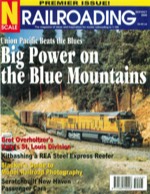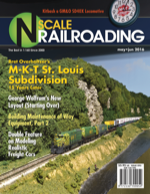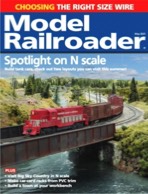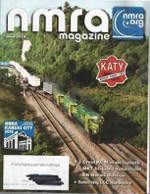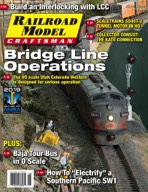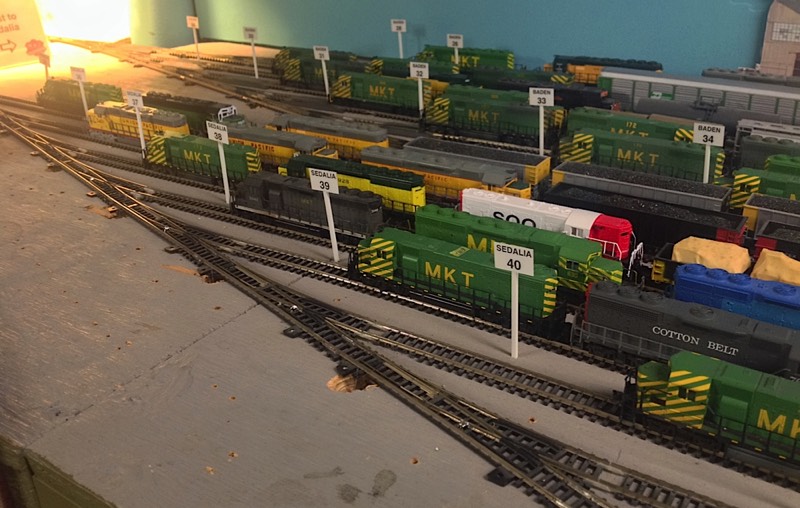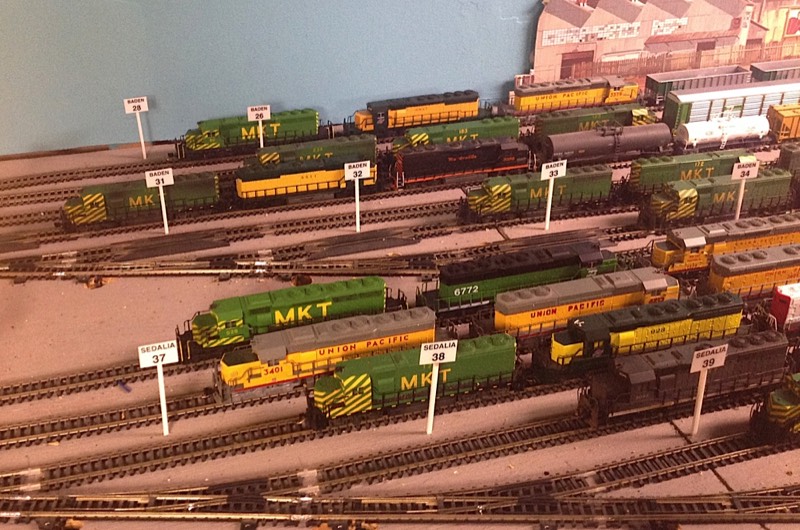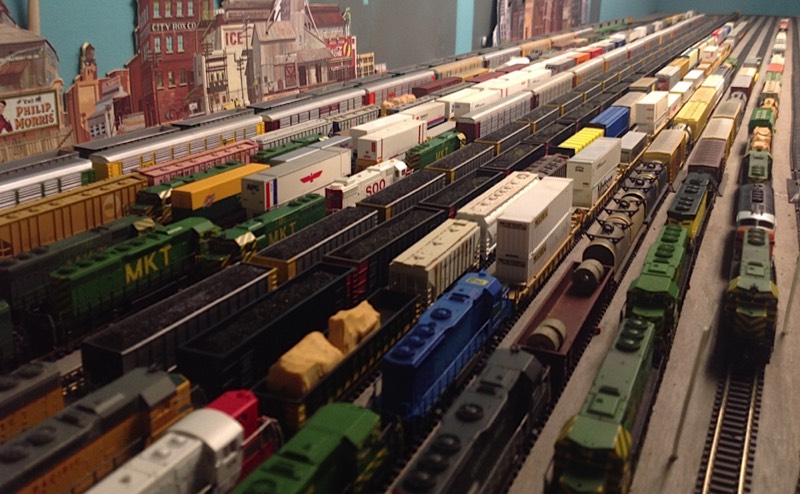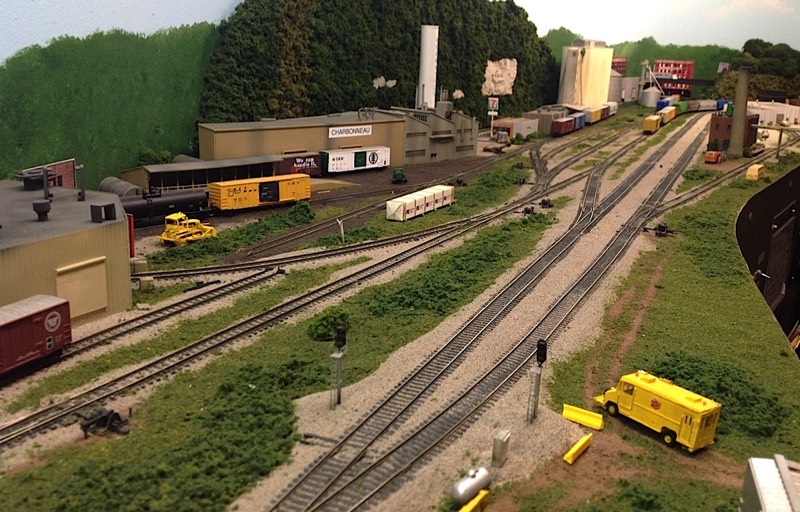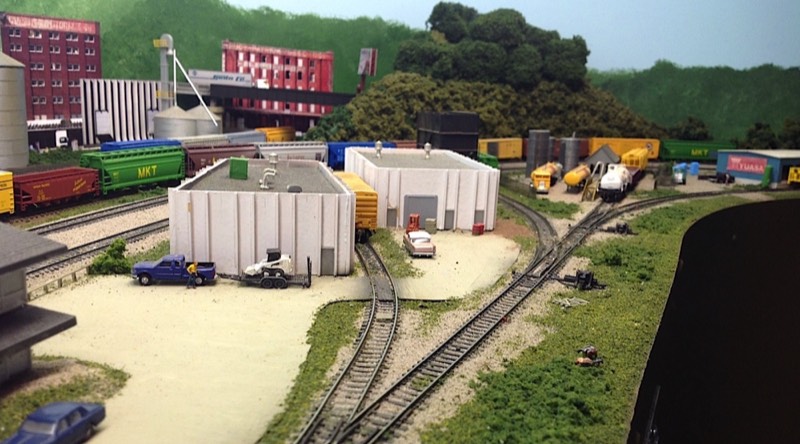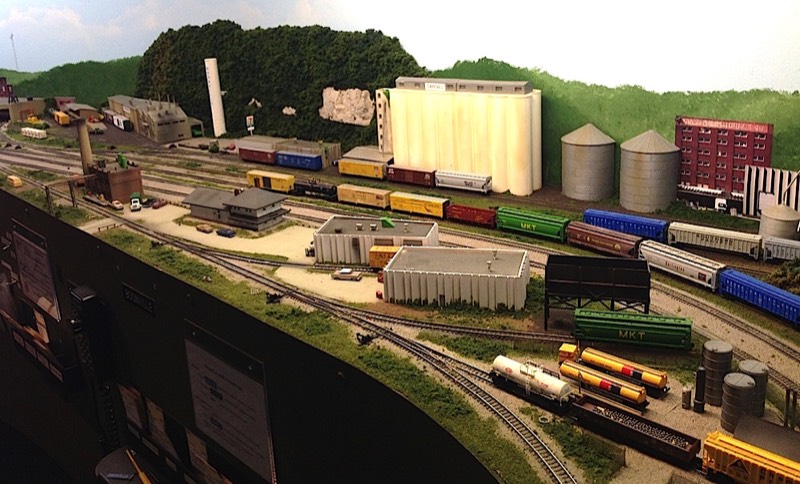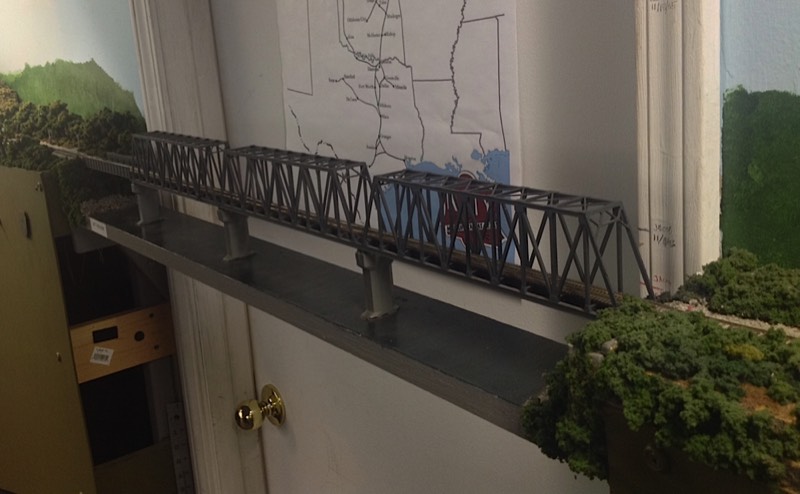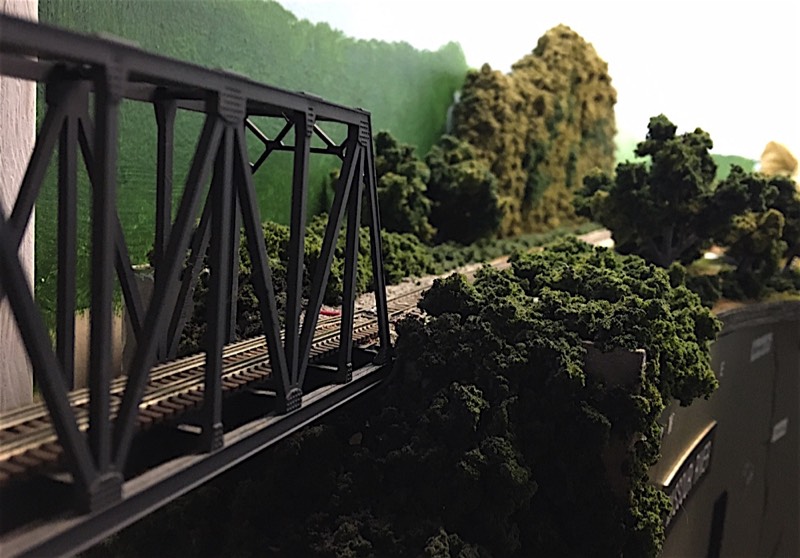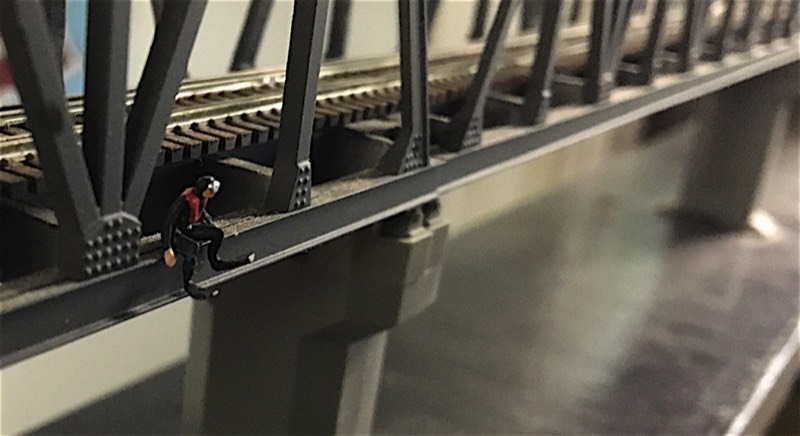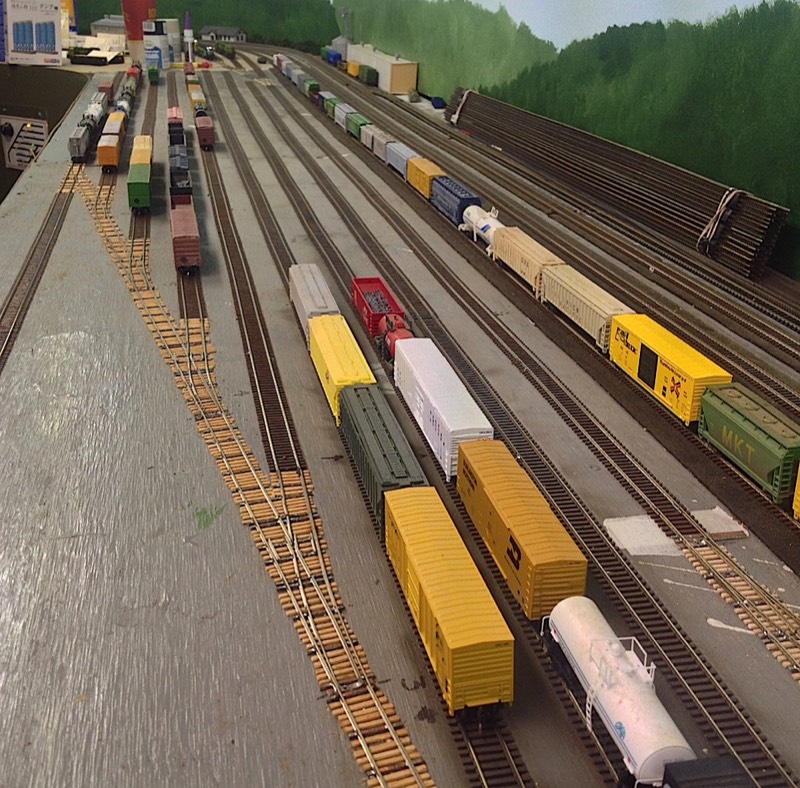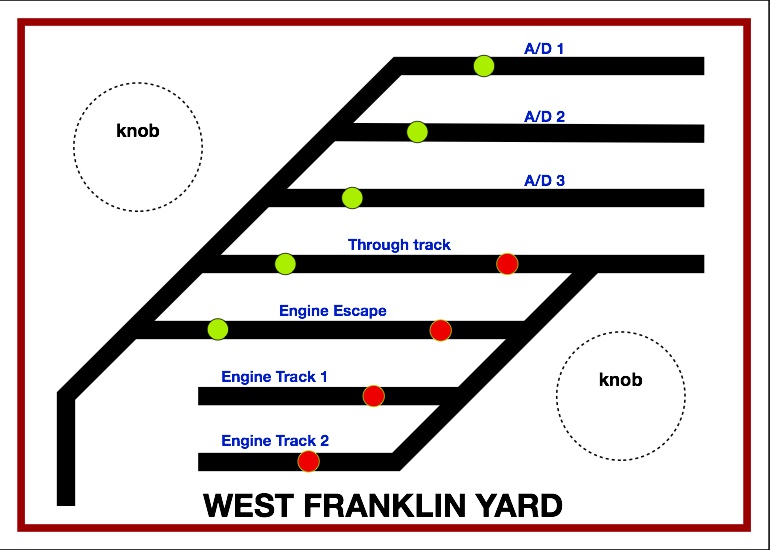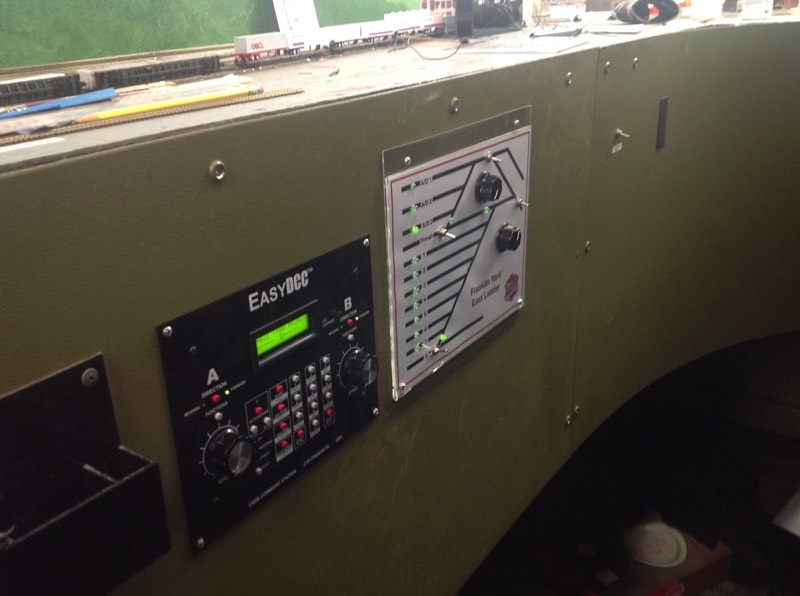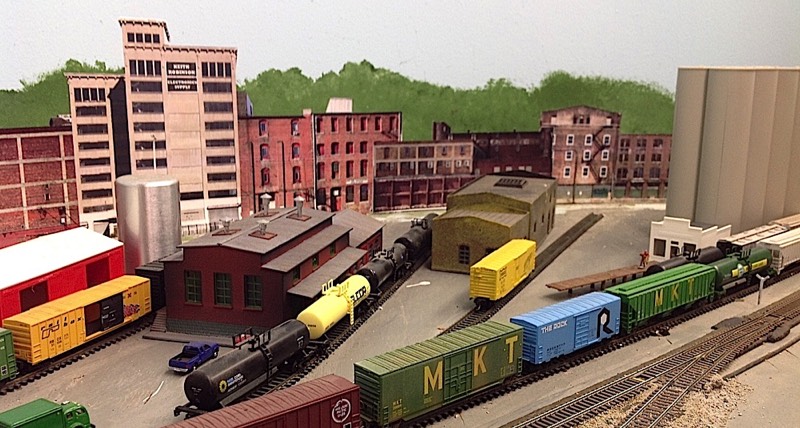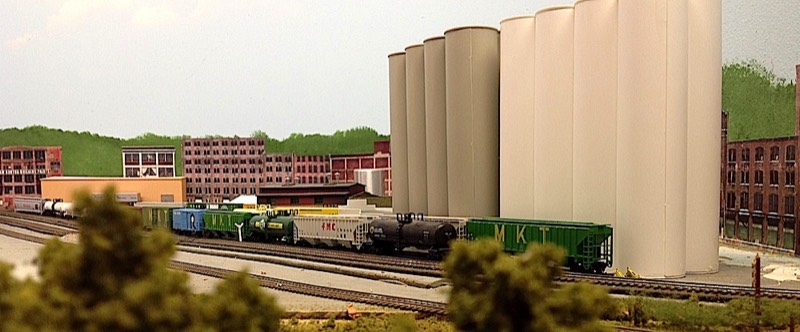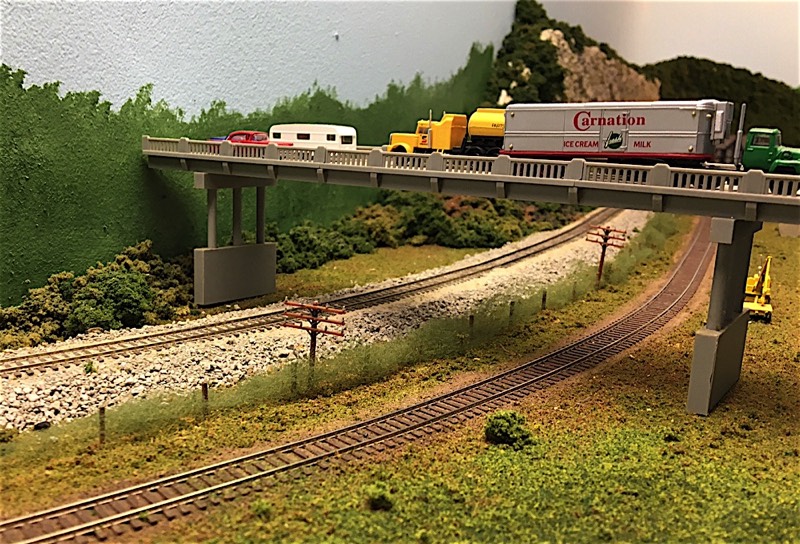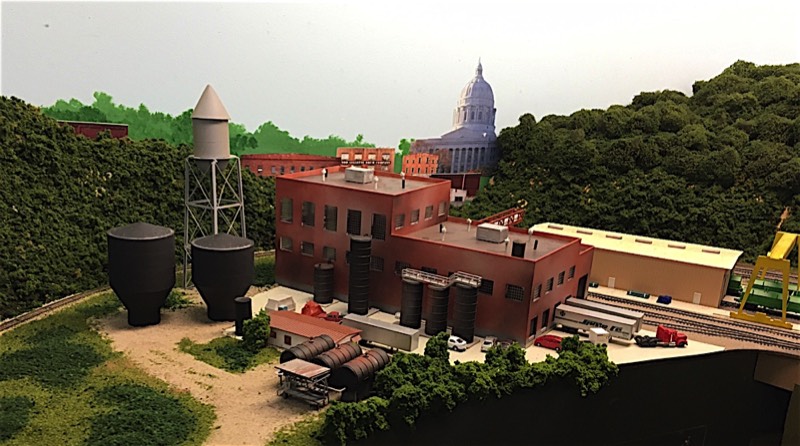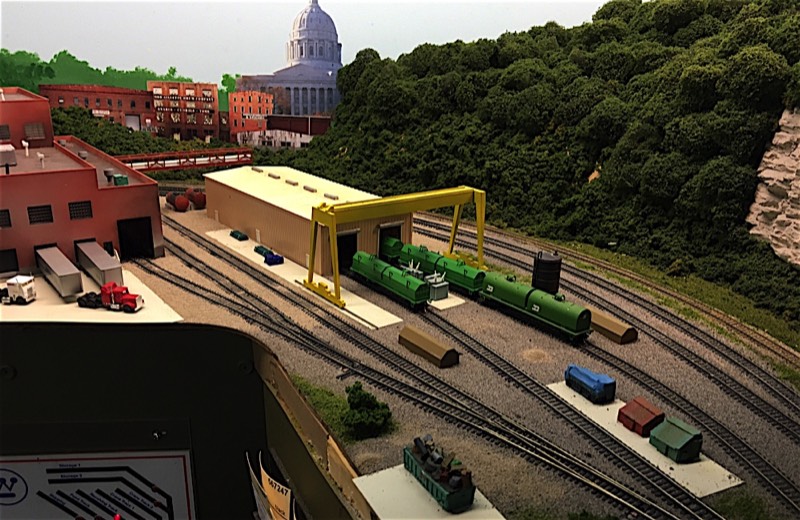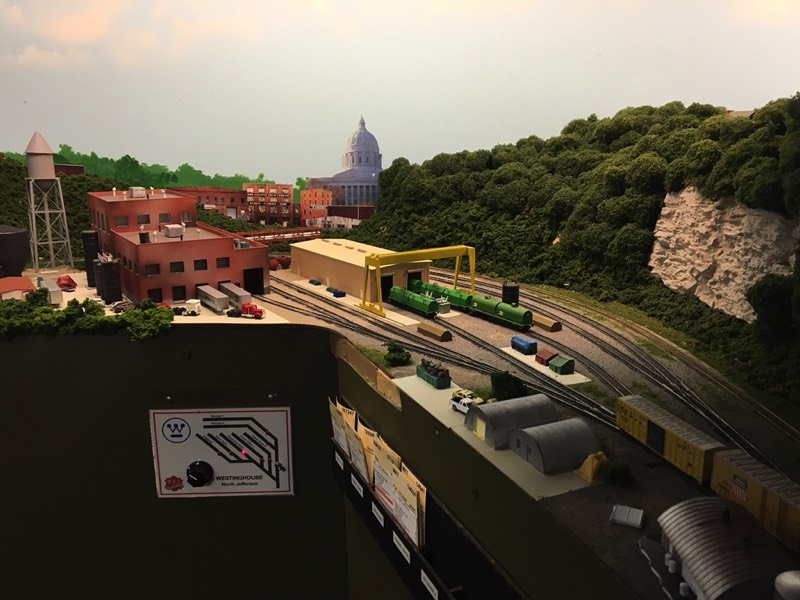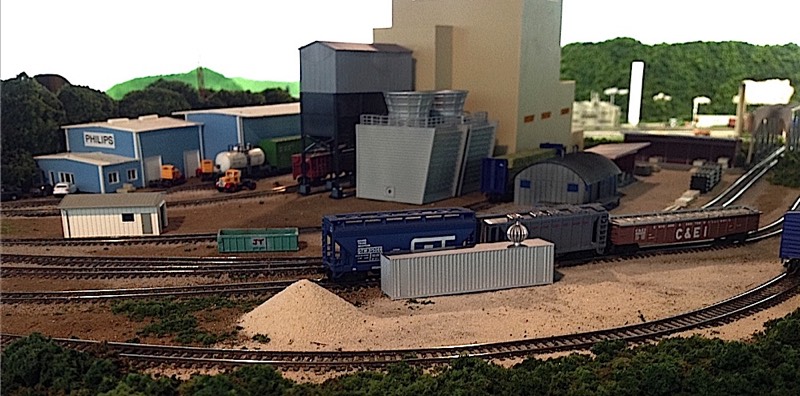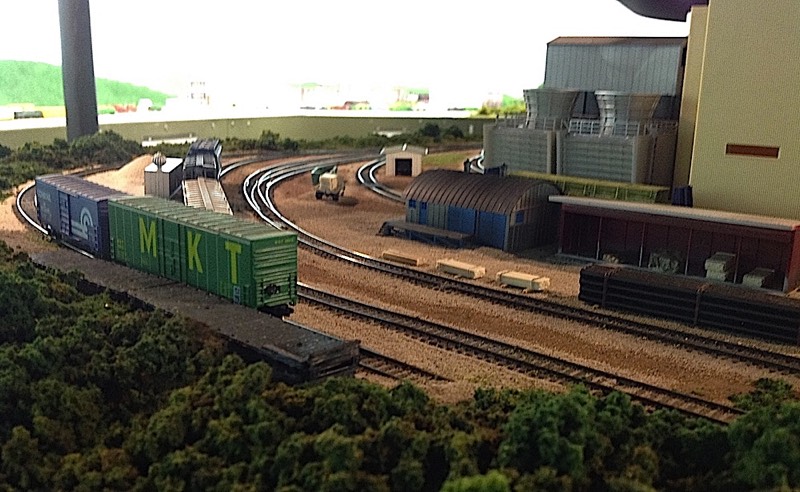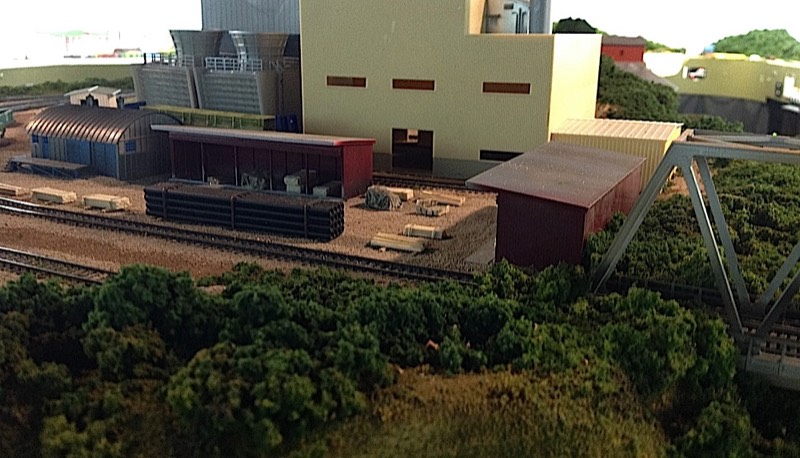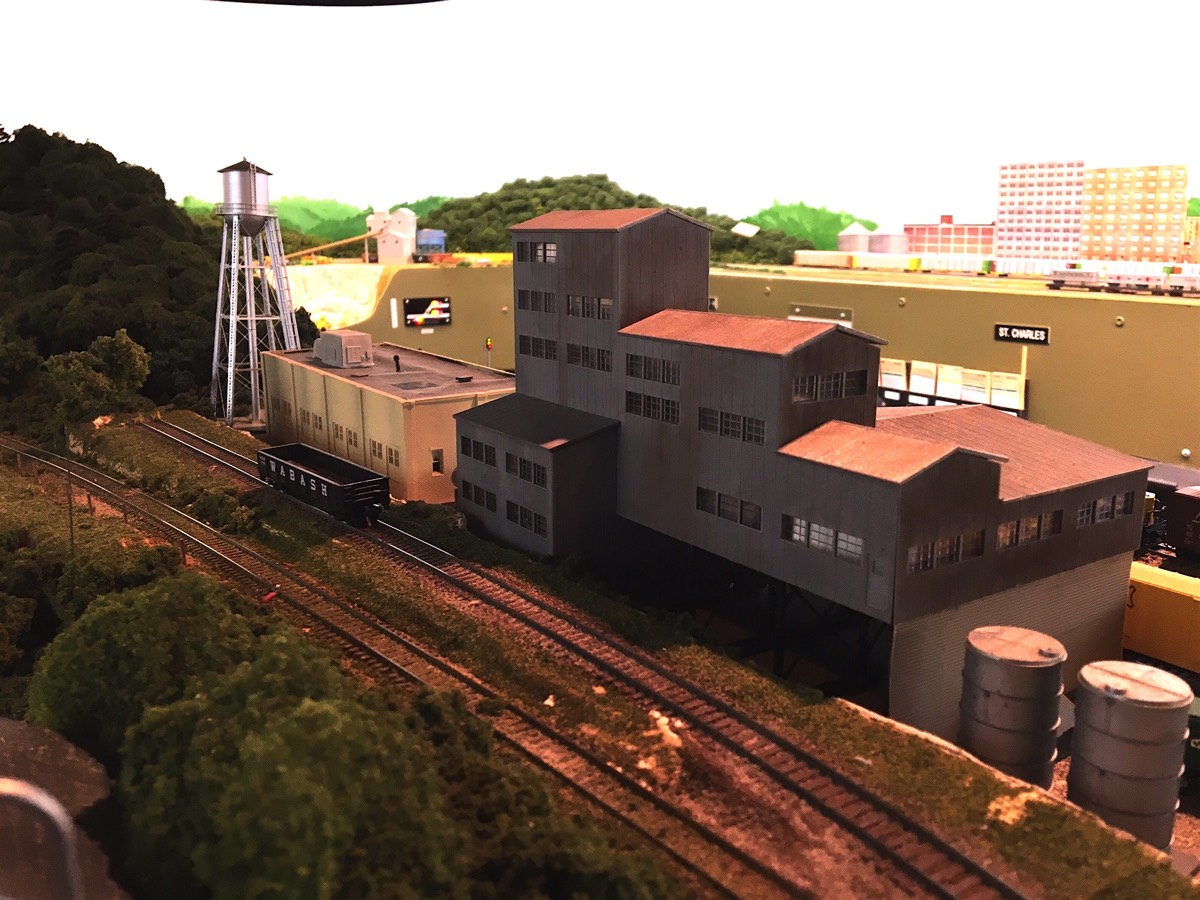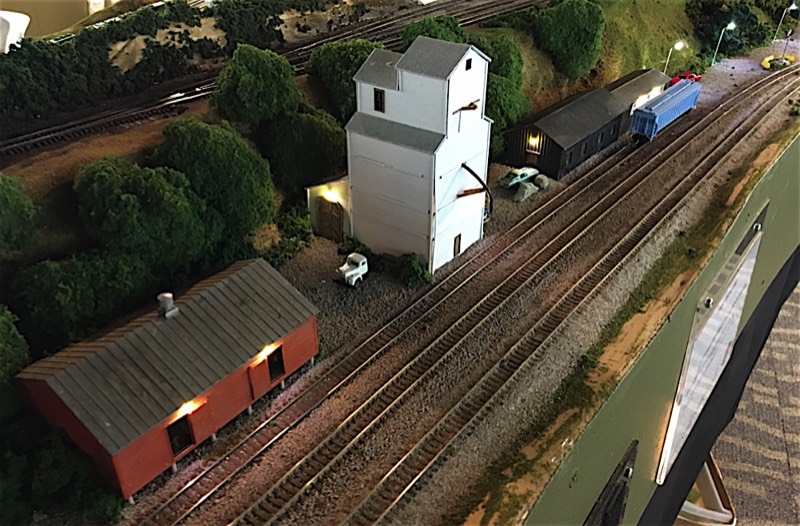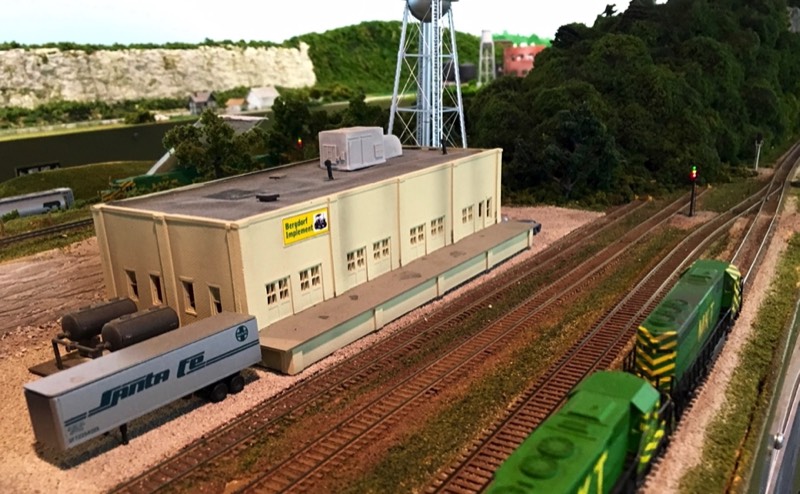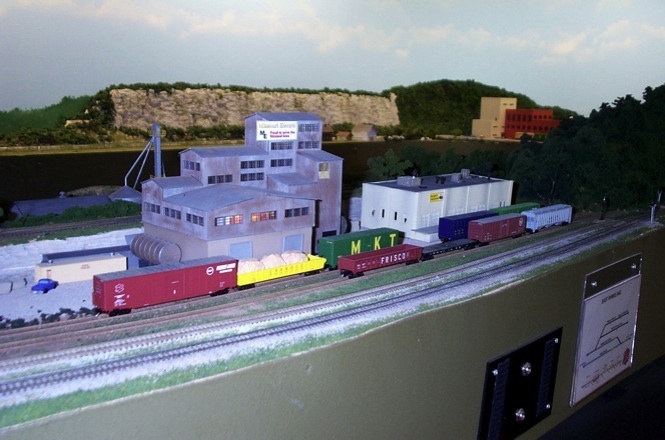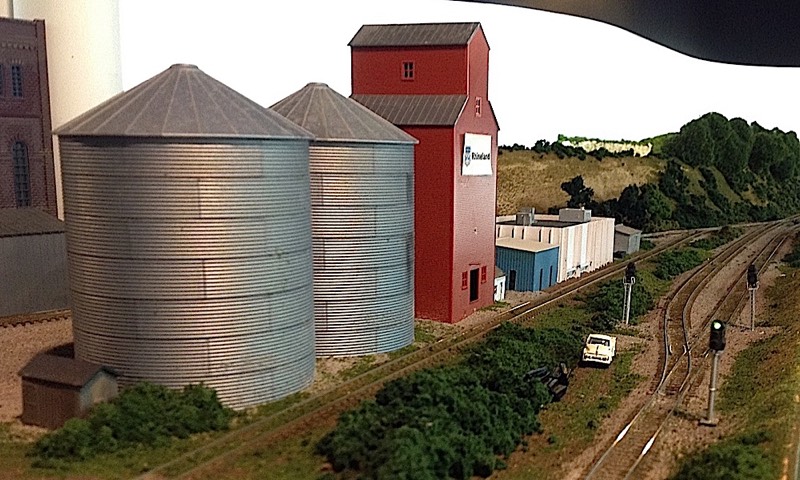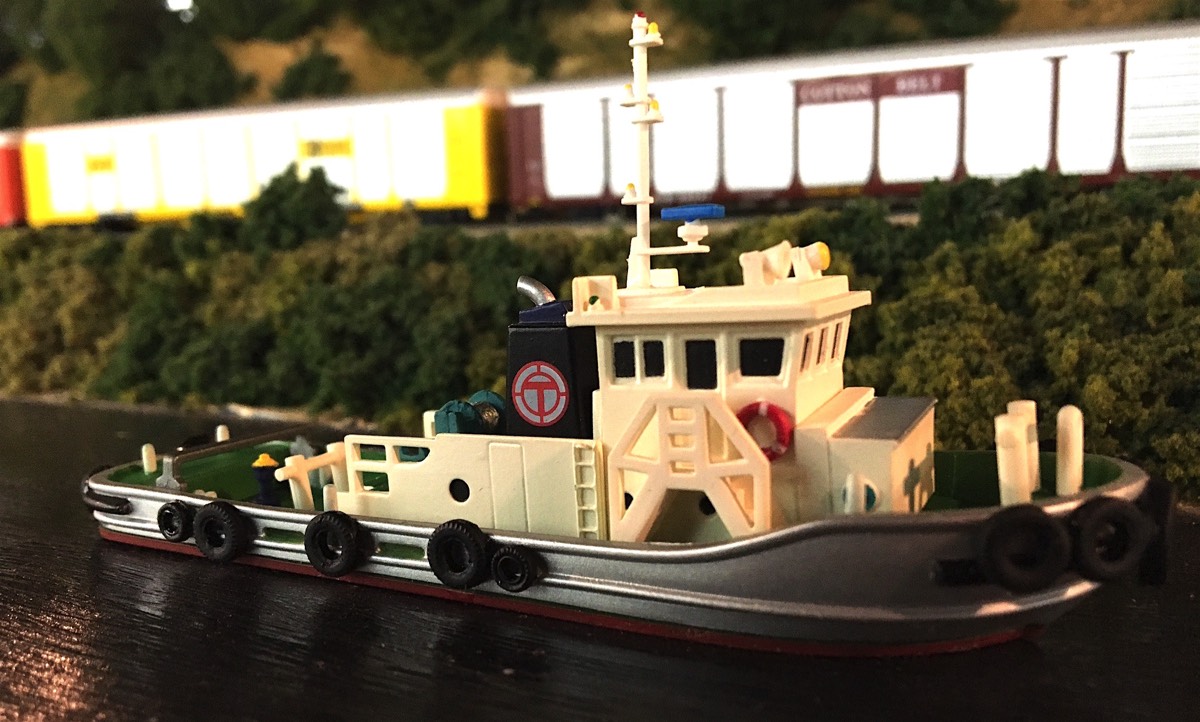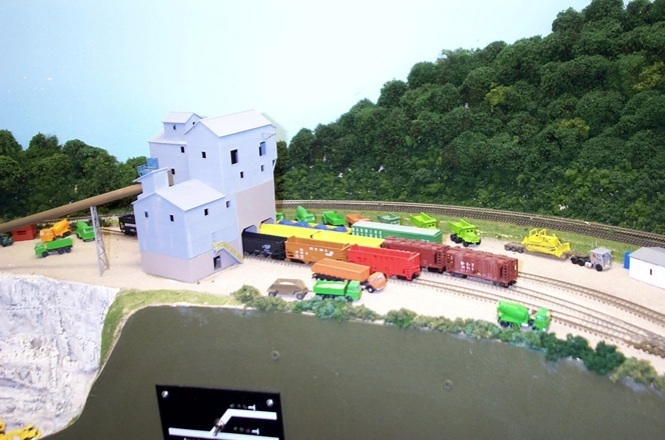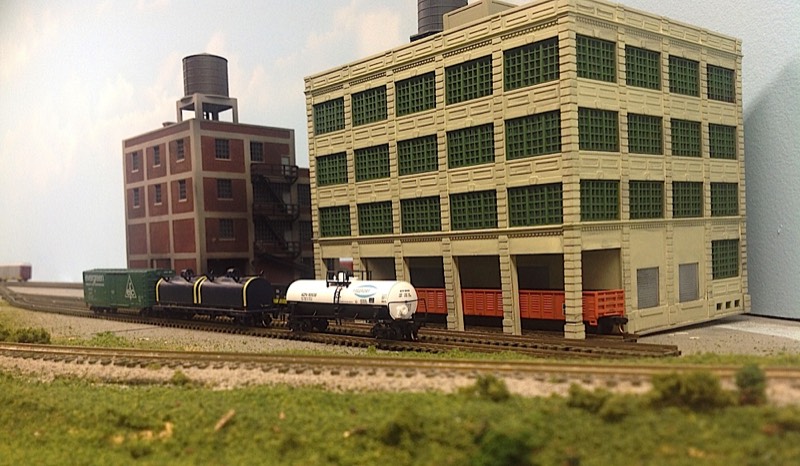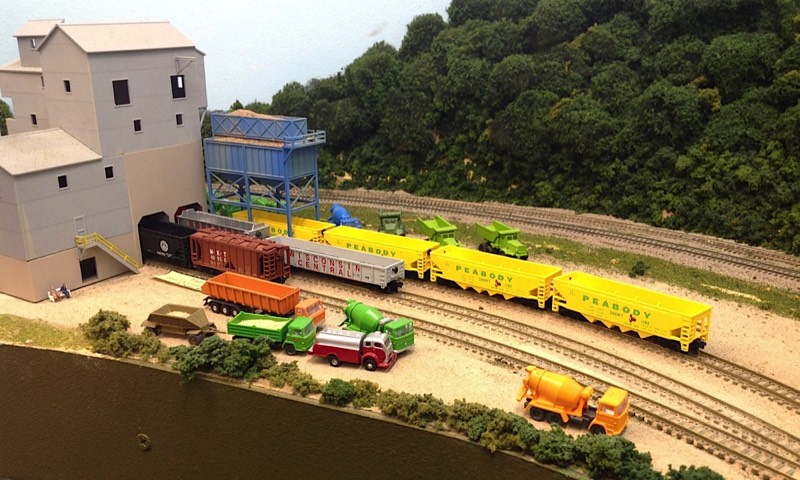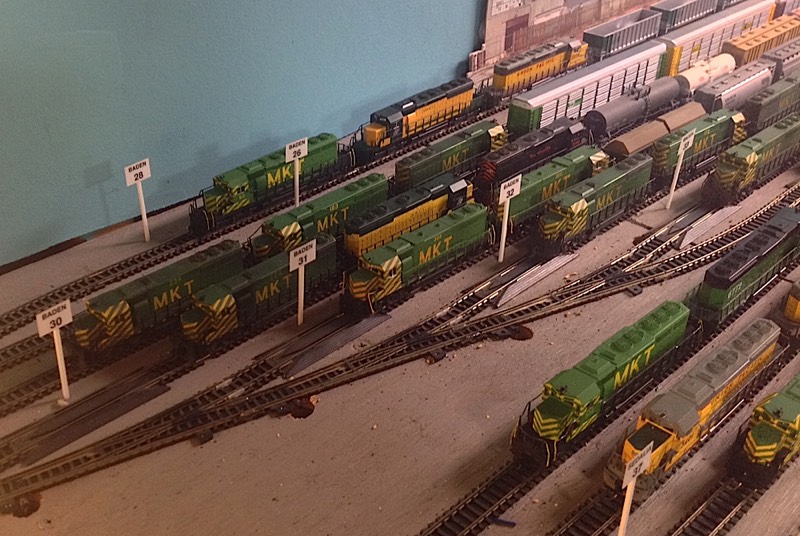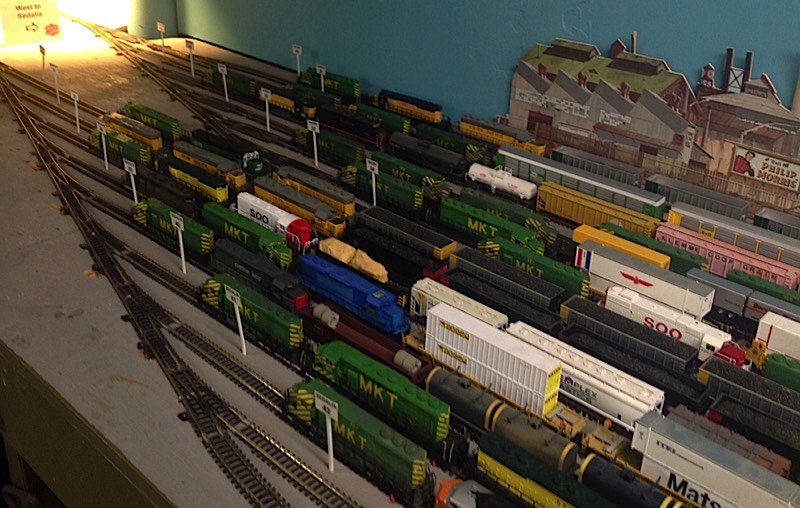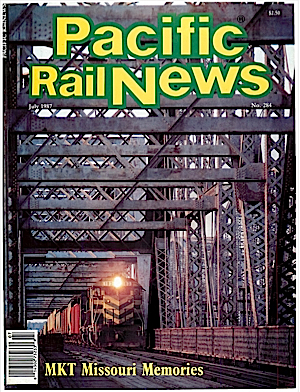
Bret Overholtzer’s Missouri-Kansas-Texas, St. Louis Subdivision
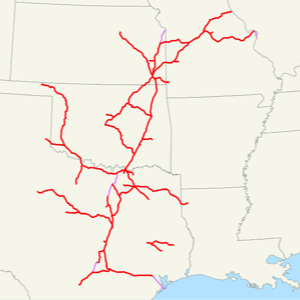
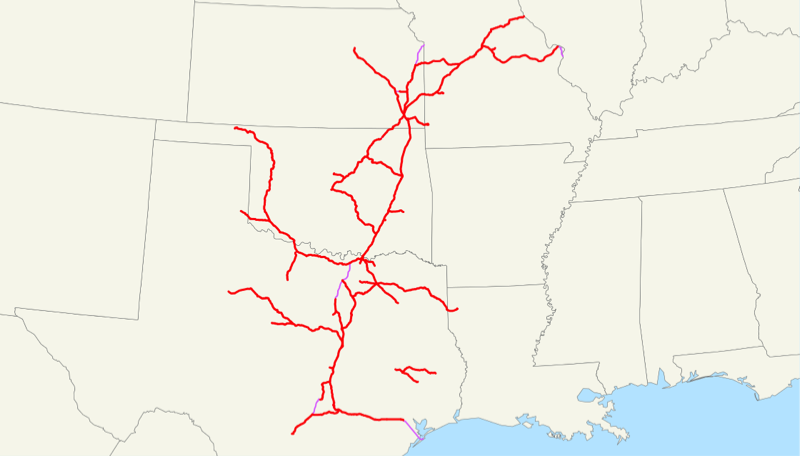
click to embiggen
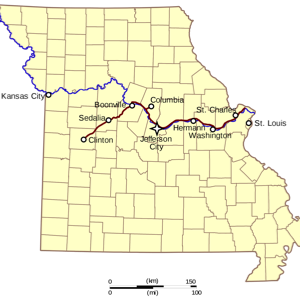

click to embiggen
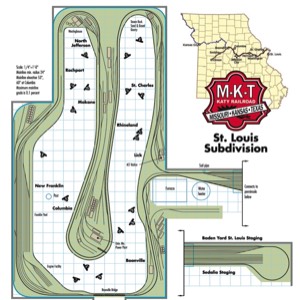
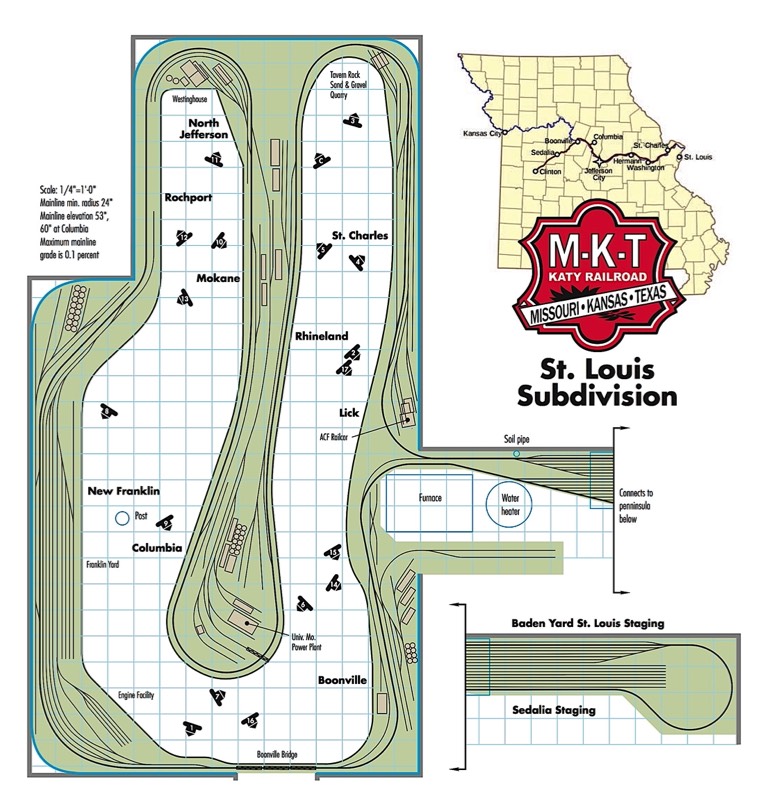
click to embiggen
About the Layout
The MKT’s traffic from St. Louis to Kansas City and Texas is simulated over nearly four scale miles of mainline track, with emphasis on freight, coal unit trains, and grain traffic.
Operations on the MKT, St. Louis Subdivision simulate an enhanced version of the traffic that would have existed in 1984. You can expect to see multi-unit freight and coal trains, some autorack and pig trains, and lots of local switching action.
You’ll run primarily Whitman green and yellow locomotives, with a smattering of leased power in the consists.
As the elite operators say, “No sound, no layout”, so the mighty MKT has sound-equipped locomotives.
An enthusiastic operating crew of eight can complete a nominal three-hour operating session with ease, running 17 over-the-road trains, up to five locals, and a dedicated Union Pacific switch job.
You can bid for the dispatching job and follow the trains across the faux-digicon-esque track schematic on the computer monitor. Or you can run the yard, and kick the local trains out to serve the industries. Or you can relax in the crew lounge and watch train videos with the Superintendent. The choice is yours!
During operating sessions, we keep the atmosphere loose and fun, with an emphasis on the social aspects of the hobby. The credo of the Mighty MKT: “Start slow and taper off”.
The MKT, St. Louis Subdivision was featured in the Sep/Oct 2000 issue of N Scale Railroading
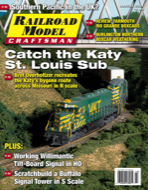
Here is an excerpt from the article on the RMC Web Site.
Of all the average railroads in the country, the Katy was the most average. ~ Casey Jones
Layout Accessibility Information

The restroom is located on the main floor of the house, up the steps from the basement and through the kitchen.
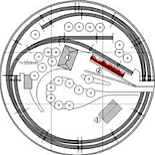
- N Scale
- Single room, 15 ft x 25 ft. with 17-track staging in separate room.
- 1984 MKT North End, from Sedalia, Missouri to St. Louis, plus branch line to Columbia, Missouri
- Walk around, linear, sincere (single time through scene), single deck
- Layout height nominally 53 inches
- 90 percent scenicked
- EasyDCC with wireless throttles (tethered available for yards)
- Full ABS signalling
- Computer dispatching console, powered by C/MRI goodness
- Basement stairs access
- 8 Operators (typical)
- Verbal track warrants using radios (supplied)
- Rule G is annulled during operating sessions
Jobs on the Layout

Job complexity/stress level: Moderate to above moderate, depending on your desire to put locals on the road. Work the 101-series trains. Kick out some locals. Chat with the dispatcher. Life is good!
Union Pacific Local at Boonville (a.m. and p.m tricks) - Works the wall-side industries at Boonville from a separate two-track staging yard. This is a good job for those who enjoy switching and rail fanning at the same time. You won’t need a radio, since you only work the UP-served industries. You will also work the interchange track and set out cars destined for the Boonville industries that are served by the MKT. The crew on the UP Boonville job will have the option of completing both the am and pm shifts, or swapping out the job for a road crew.
Job complexity/stress level: Easy to moderate. Lots of switching, but you have no schedule. Take your time. Do some railfanning. Haughtily deride the puny MKT trains as they ramble by. Life is good!
Four Local Jobs (Columbia, Westinghouse, St. Charles, Boonville) - These locals all originate at Franklin Yard. They work as turns, departing and returning to the yard. A couple of the locals (Westinghouse, Boonville, and Columbia) work only a single destination; the St. St. Charles local works several towns out and back. Most locals are short (9-11 cars) , so the local switching does not take all session to complete.
Job complexity/stress level: Easy. Do some switching. Dodge the through trains. Chat with the dispatcher over the radio. Trundle back to the yard. Life is good!
Road Crews - The St. Louis Sub usually runs with 4 road crew. There are 17 trains to get across the layout in a typical 3-hour operating session. Since the mainline run is not particularly long, the duration of many of the runs is lengthened by an switching maneuver or two (the autorack trains will spot and pull cars from the auto ramp at St. Charles, the pig trains will pick TOCF at the pig ramps). The 100-series freight trains will work the interchanges at Boonville and St. Charles, and will also block swap cars in the yard. The higher priority trains (coal, COFC, and expedited freight) will run the layout with no additional work.
Job complexity/stress level: Easy-peasy. Run the road. Eat snacks, Railfan a bit. Run some more trains. Chat with your friends. Life is good!
Dispatcher - The dispatcher’s desk is located just off the crew lounge, near the main staging area. Dispatching tool include a typical dispatching sheet, a computer monitor with track schematic that also serves as the means to select the staging tracks, and a separate monitor to view the staging track ladders. Dispatching the MKT, St. Louis Subdivision is fun and easy - it’s a great job for the beginner or novice dispatcher.
Job complexity/stress level: Easy to moderate. Click a mouse, and select staging tracks. Talk on the radio. Eat some snacks. Embrace the power that is yours for 3 hours! Life is good!

Growing up, I was an off-and-on railfan and modeler, building a few small layouts. In 1990, I moved to Kansas City and became involved in the local N-Trak club. I spent several fun years with the N-Trakkers, going to shows, running trains, and engaging in the social aspects of the hobby. With my father, also an avid N-scaler, I travelled to several shows and conventions throughout the midwest, while I planned the basement layout.
I decided to model the Katy after hearing stories from my father-in-law about the passenger and freight trains from his early days at New Franklin and Columbia, Missouri.
When we built our house in 1990, my wife, Eileen, said that I could have the entire basement for the layout. Well, I knew that wasn’t going to work with the amount of junk we had already accumulated and the family we were anticipating. So I divided the basement into thirds: a third for storage, a third for a family room, and a third for the layout. That decision has proven to be wise, for the kids still use the family room, and our storage room is bursting at the seams.
My father’s untimely passing in 2002 left a hole in my railroad enjoyment that will never be filled. It took me a while, but I got back in the hobby with the help of several good friends in Kansas City.
For years, the layout was DC-powered using a computer cab control system integrating Bruce Chubb’s Computer/Model Railroad Interface. The layout ran great for several years, but soon the time was right to convert to DCC. We still use the C/MRI for block occupancy, the ABS signals, the mouse click staging yard, and the dispatching console.
With the help of my friends, model railroading has become fun again - or as we say in Kansas City: It’s okayyy…I guess.
Layout Tour

Geographical Overview
Another MKT Division ran from Parsons to St. Louis, Missouri, crossing the Missouri River at Boonville, Missouri. This Northern Division ran on track just north of the river to St. Charles, Missouri. At St. Charles, the MKT track angled north to meet up with the old CB&Q line at Machens Junction. The MKT track ended at Machens, and the MKT trains continued over CB&Q/BN track to the terminal MKT yard at Baden, Missouri.
The northernmost portion of this Northern Division, from Sedalia to Baden Yard, was called the “St. Louis Subdivision”, and is the portion modeled on this layout.
A good historical overview of the MKT (although with a Texas emphasis) can be found here.
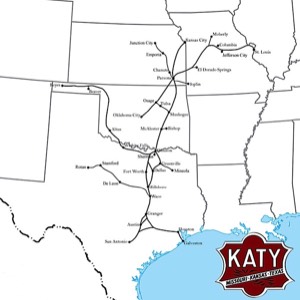
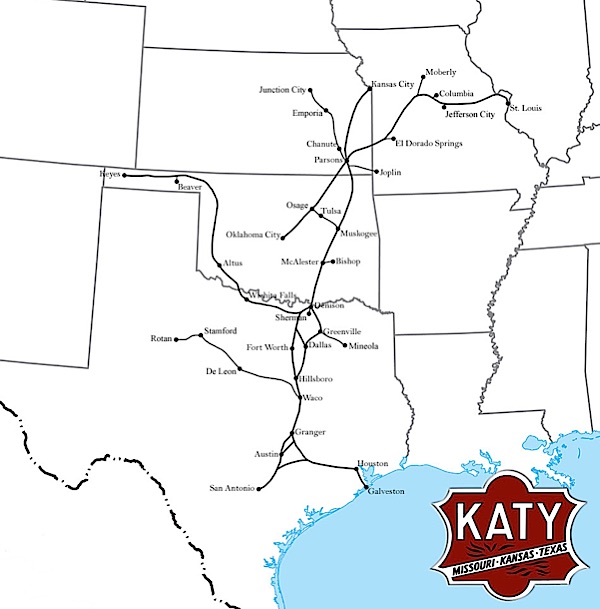
click to embiggen
System Map

Primary Locations on the Layout
The west end staging is located in a separate room from the main train room. The ten track single-ended set of tracks contain eastbound trains, originating from Dallas, Houston, and the big classification yard at Parsons, Kansas.
Although these track are called “Sedalia” tracks, the town of Sedalia is not modeled on the layout; the name Sedalia is just representative of off-layout destinations tp the west of the modeled portion of the railroad.
Staging turnout are controlled via the computer dispatching panel and also by operator-controlled panels at the staging fascia.
During an operating session, the dispatcher selected the staging tracks in and out of the staging yard. A pair of LED signals located in the train room can be used to monitor the progress of the train a it enters the staging room. Slow and rapid blinking aspect tell the operator that the train is approaching and then straddling the staging ladder. The LED goes solid red when the train is fully in the staging track and clear of the ladder.
Boonville is the first town on the visible portion of the layout east from Sedalia Staging. The MKT interchanges with the UP/MP at Boonville, and there are several industries to switch in town.
The UP switching job is popular with rail fans operating on the MKT, St. Louis Subdivision, as you can switch cars AND watch the trains go by at the same time! On the prototype, the grade out of the Missouri River valley south out of Boonville was the ruling grade on the entire MKT system.
The Missouri River Bridge is a scenic element on the MKT, St. Louis Subdivision. Used to provide a lift-up opening across the door to the train room, the prototype bridge at Boonville was a lift span across the Missouri River.
In the steam era, Franklin Yard served as a division point and helper district for for the long grade south out of the Missouri River valley (the ruling grade on the entire MKT system). In 1984 on the St. Louis Subdivision, Franklin Yard is a busy classification yard, receiving cars for distribution on the visible portion of the railroad and for destinations east and west. A diesel servicing facility is located at FY, and many through trains will have their locomotives refueled at this location.
Originally established in 1828 after a flood destroyed the original town of Franklin, New Franklin has enjoyed an historic and colorful history. This area was the official beginning of the Sante Fe Trail and is the site of the Hickman House, the oldest known brick structure west of the Mississippi River. The St. Louis Sub serves the local industries here, including the bustling New Franklin Industrial Park, with its mix of contemporary and traditional industrial clientele. New Franklin is also the site of the Yellow Dog Cafe, where MKT trainmen grabbed many a greasy sandwich for the journey to St. Louis.
North Jefferson is located just across the river from Missouri's State Capital, Jefferson City. North Jefferson is noted as the location of North End's largest customer, Westinghouse.
Maker of large commercial and custom transformers, Westinghouse is a prized client of the MKT, and warrants its own regular local train out of Franklin Yard. Shipments of inbound coil steel and outbound transformers can be seen regularly at Westinghouse.
Columbia is served by a branch line off the main, called the "Nine-mile" because it was nine miles long. The Columbia Branch climbs gently out of the Missouri River valley along Perche Creek to the bustling college community. The MKT serves several industries at Columbia, including the big Philips Lighting Plant and the power plant for the University of Missouri.
Mokane is a small farming community located just east of the branch line to Columbia. Basically just a siding with a few industries, many westbound trains are held at Mokane awaiting permission to enter Franklin Yard. Mokane derives its name from the original railroad that established the town, the Missouri, Kansas & Eastern, or MK&E. Mokane is correctly pronounced “mo-KANE-ey", but most railroaders use the more intuitive "MO-kane".
Rhineland lies in the lush wine country of Missouri's "Rhine Valley". The town was founded by German emigrants who dreamed of a New World utopia that would be "German in every particular." Rhineland now boasts a Bunge soybean processing plant, a Yuasa Battery manufacturing facility, and several long-time local industries that have been served by the MKT for decades.
St. Charles, now a bedroom community for St. Louis, has grown with the MKT since the late 1800, when the Missouri, Kansas, and Eastern was built from St. Louis west. The MK&E trackage eventually became the St. Louis Subdivision of the MKT. Several industries are served by the Katy at St. Charles, most notably the Tavern Rock Sand and Gravel Company. Noted for its vein of ultra pure silica sand, Tavern Rock was busy in the late 1950s and early '60s providing silica for missile nose cones. Tavern Rock is busy today providing sand for all the major glass makers in the US and Canada.
Other major industries at St. Charles include the the piggy back trailer-on-flat-car ramp, an auto rack facility, the ACF Rail Car repair facility and the interchange with the Norfolk Southern.
Baden Yard (East end staging) marks the end of the line for the MKT. Baden Yard was reached via CB&Q (later BN) trackage at Machens, and across the Bellfontaine Bridge to near downtown St. Louis just north of the St. Louis Arch. In years past, Katy passenger trains would continue to the St. Louis Union Station. As modeled on the St. Louis Sub, Baden is a terminal yard, and interchanges eastbound revenue cars with several railroads on both sides of the Mississippi River.
The St. Louis Terminal Railway Association (TRRA), partly owned by the MKT, provides interchange service between Baden and the other local railroad yards. Alas, the real Baden Yard is long gone…
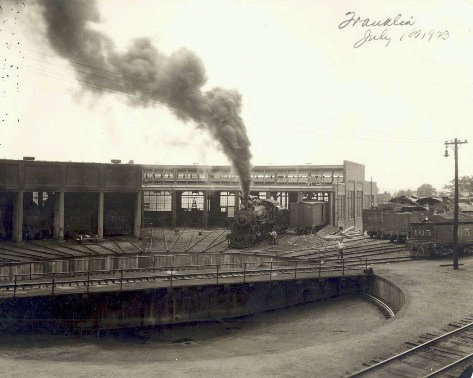
The tracks of the Missouri-Kansas-Texas Railroad were completed to Franklin in 1893. A roundhouse and shops were located in low, swampy, bottom land just southwest of New Franklin, known as Franklin Junction. In 1895, a two-story depot was built at this section and served as a division terminal office for twelve years. It was moved to a location closer to New Franklin on a string of flatbed cars and later burned.
In 1906, the Businessmen's Association of New Franklin acquired the land for the railroad to build a reservoir to supply water for the mighty steam engines. This secured the permanent division point for location at the Franklin Junction yards. The Katy Reservoir, as it became known, lies just to the north of the railroad yards at Franklin.
The expenditure of 15.5 million dollars by the Missouri-Kansas-Texas Railway in 1923 for improvements to the railroad yards, again assured the growth and continuation of the railroad division point location in Franklin Junction.
Construction of a forty-room hotel, a new powerhouse, an addition to the roundhouse and a new 90-foot turntable, were built by the Katy, along with machine stops, a new depot and office buildings. An immense oil tank 30 feet high and 114 feet in diameter with the capacity of 55,000 barrels of oil was erected to store oil for locomotives. Franklin became an important railroad center in 1923. Katy payroll was nearly a half-million dollars in 1930-31, with the New Franklin-Franklin area being the second largest of the companies in the state.
The beginning of WWII, 1939-1945, produced floods of rail tonnage and consequent year of prosperity for all railroads. Unfortunately, coal, chemicals and petroleum derivatives needed for treating the railroad ties were in short supply, as was good quality timber. Some twenty to twenty-five years later the wartime installation of inferior ties and the long stretches of fifty and ninety pound rails posed serious problems in the maintenance programs of the Katy as the postwar fortunes of the Katy deteriorated.
By the 1980s, it was evident the once undaunted, proud, thundering rails of the pioneering Katy were losing steam. The Katy was sold to the Union Pacific Railroad in 1986 and all her rails across Missouri lay abandoned and silent.
In the spring of 1990, the Missouri Department of Natural Resources transformed the 225 mile long rail beds into the Katy walking and bicycling Trail State Park, following the diverse and beautiful countryside of the once thundering rails known as the "Katy."
A little more about the Columbia Branch
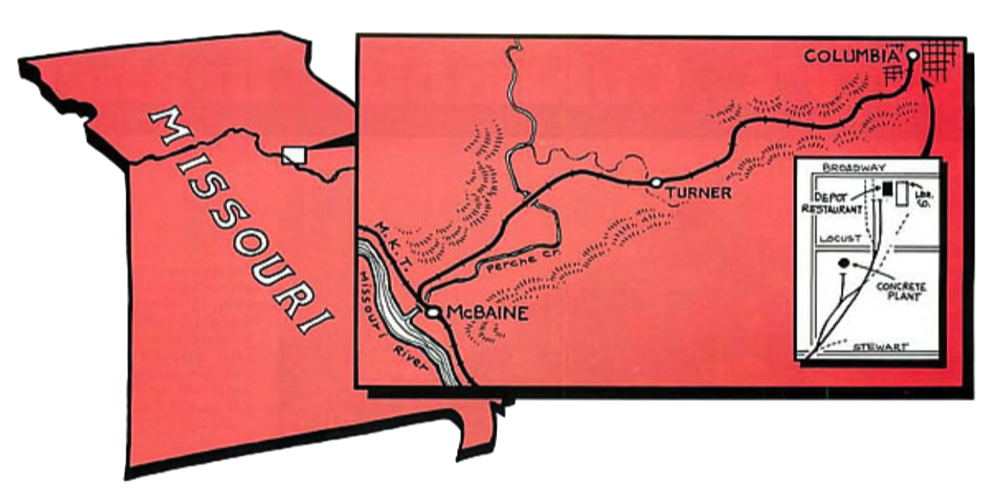
Running nine miles from McBaine to the end of the line, the branch line to Columbia has an interesting and diverse history.
Much of the original 75 lb rail originally laid down in 1901 was still in use when the branch line was removed from service in 1977, following a suspicious trestle fire just south of town.
The locals always ran during the week, never on the weekends, to make sure that the section crews would be available in case of a derailment…which happened often on the Columbia Branch.
Locals were called “as-needed” and the trains run under a standing 5 mph speed restriction along the entire length of the Columbia Branch. The locals were served exclusively by GP-7 - the lightest locomotives in the Katy fleet.

Images of the Columbia Local - 1975-1976
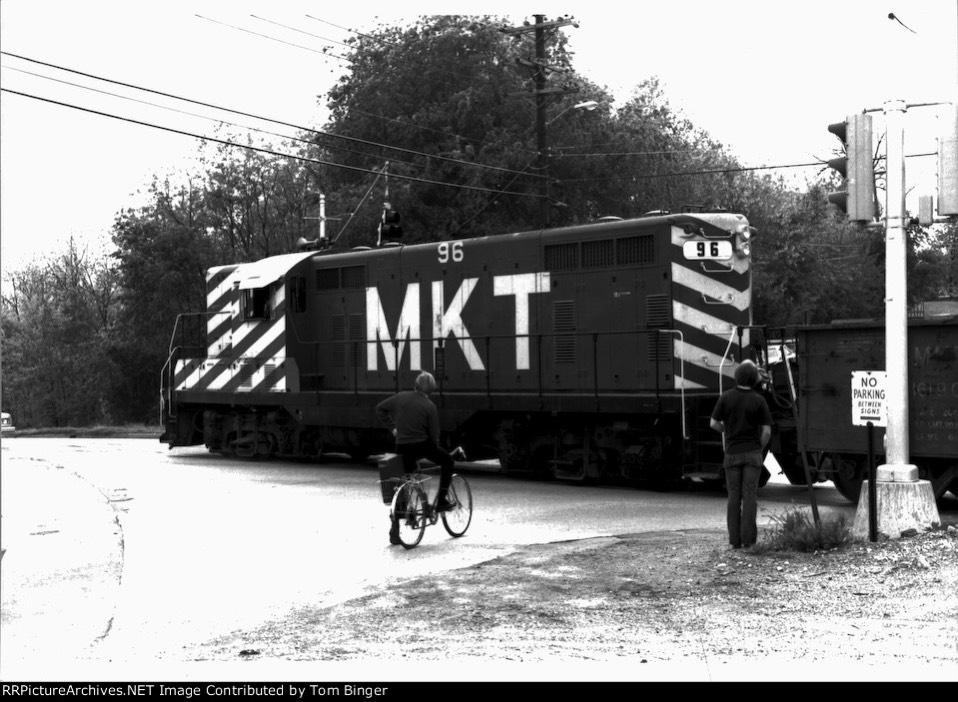
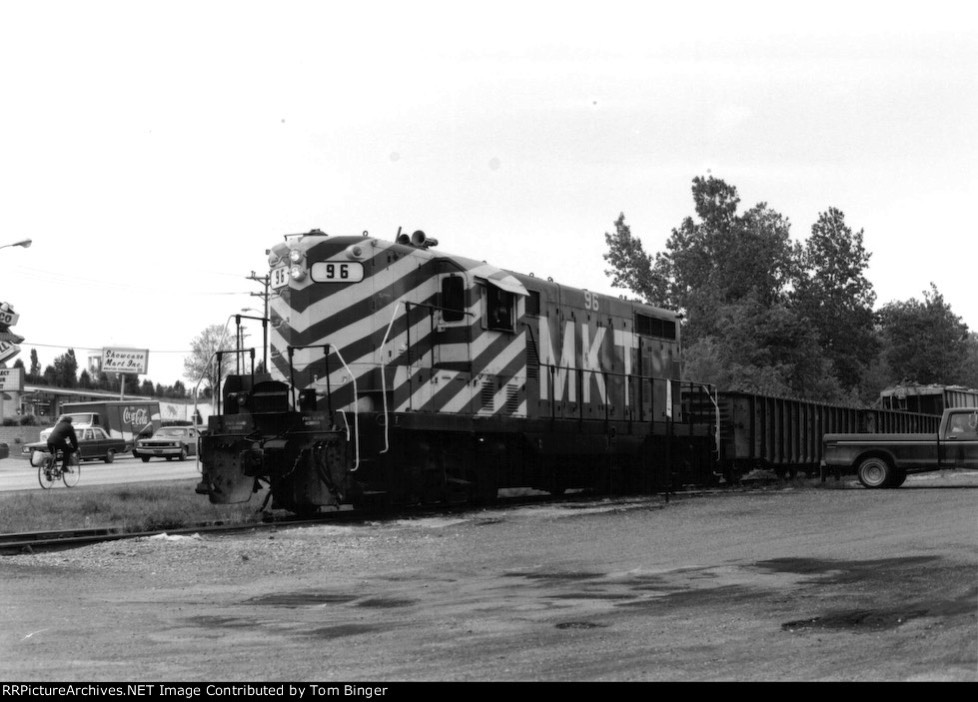
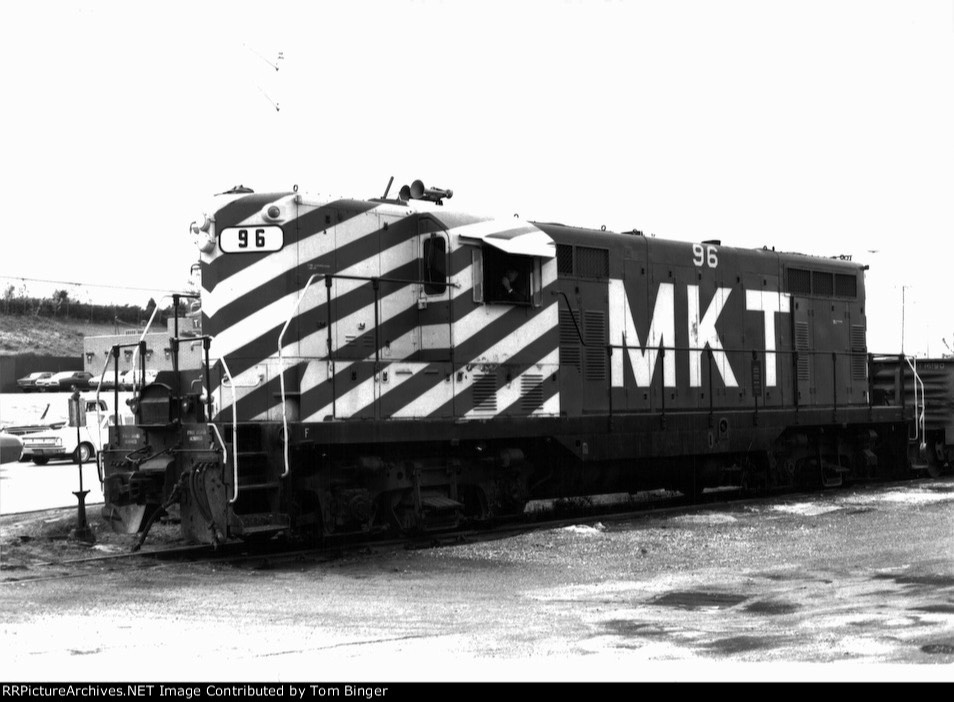
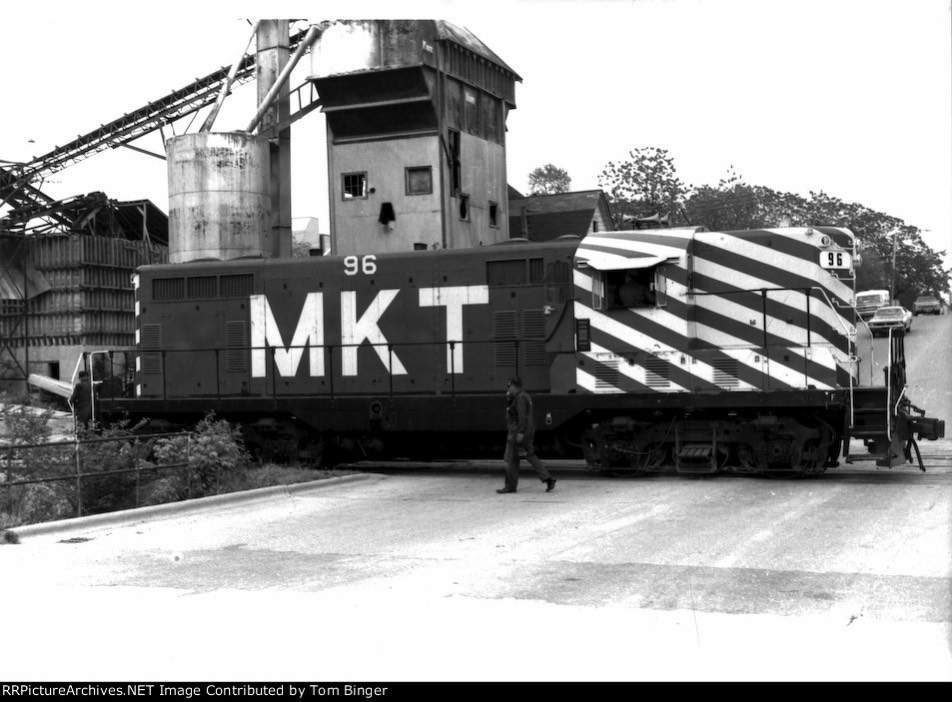
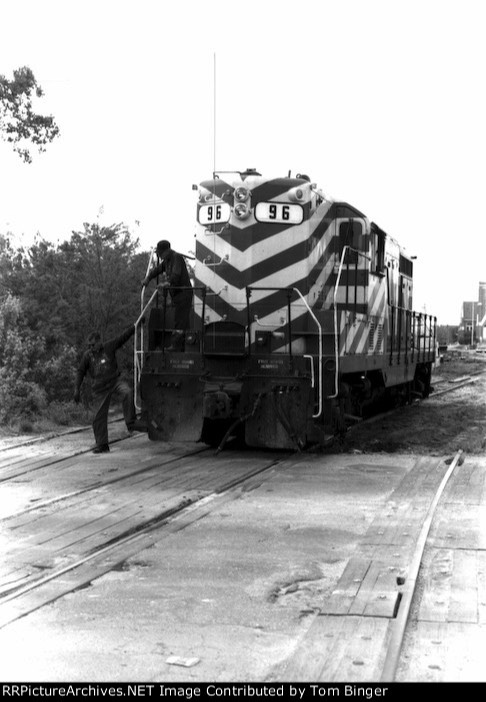
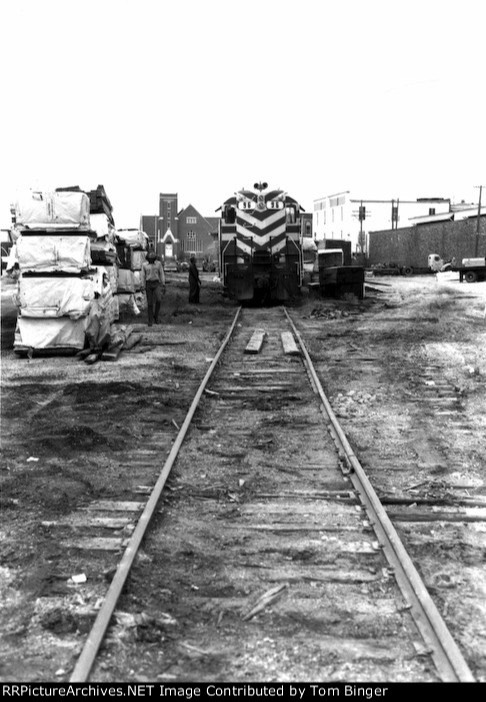

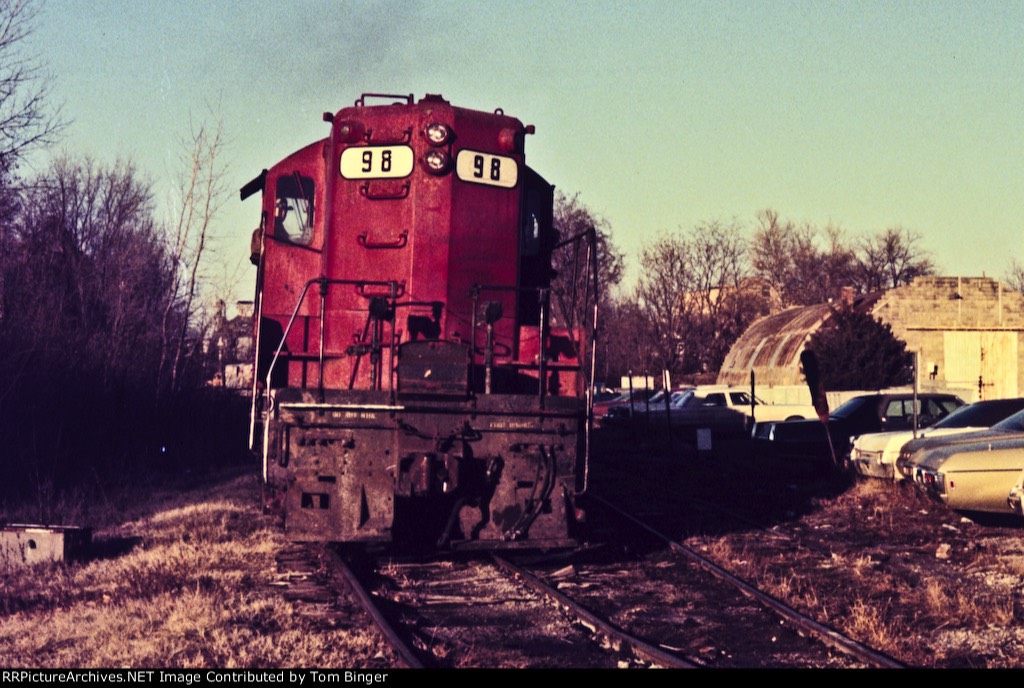
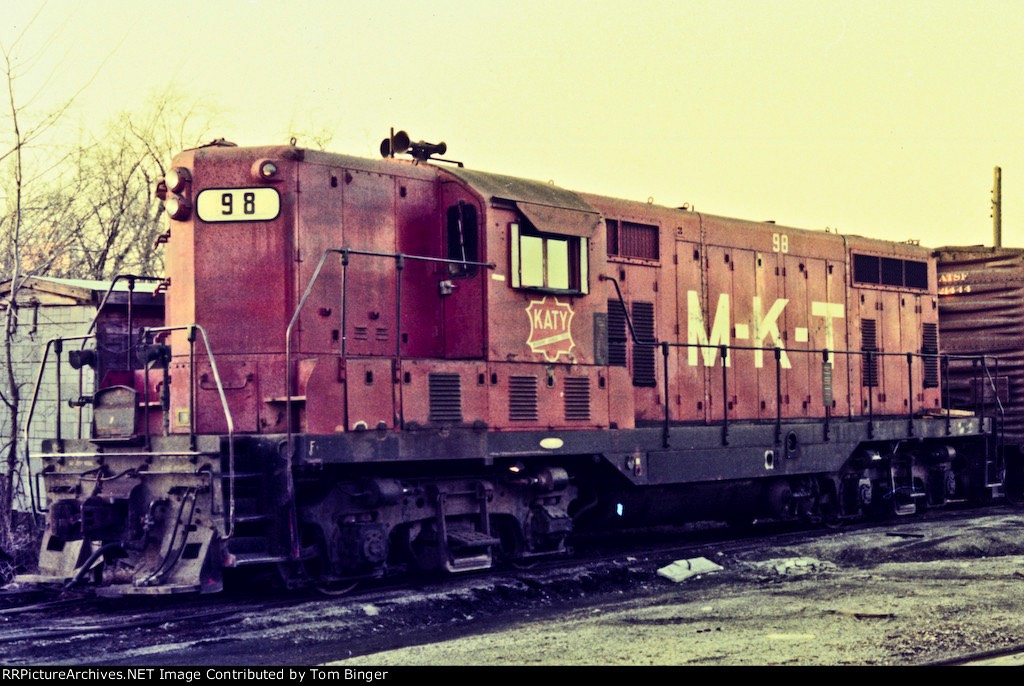

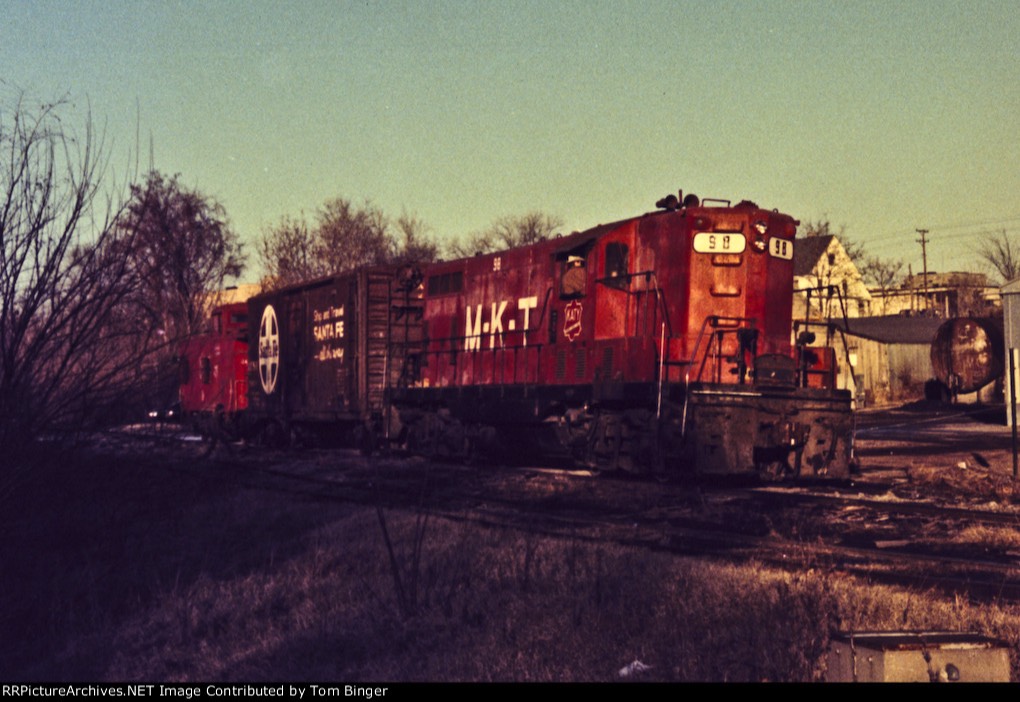
MKT Videos!
Please consult your physician for excitement lasting more than four hours. Don’t say we did’t warn you…
MKT Extra 197 eastbound at Kirkwood, Missouri - August 21, 1988 (The Katy’s final day)
The last Katy train to cross the Missouri River Bridge at Boonville - May 23, 1986
A great tribute to the MKT - the groovy music is just an added bonus!
MKT Extra 327 passing North St. Louis - April 10, 1988
MKT Extra 327 passing North St. Louis - April 10, 1988
Trains of St. Louis - 26 minutes of great railfanning from the late 1980’s, including the Katy, MP. the Rock, IC, UP. and others!
In case you were wondering…
Or like calling the Chiefs a professional football team.
ps: feel free to call me “Slim”
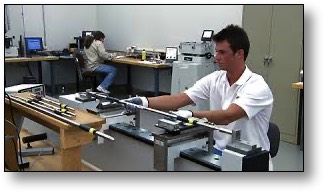
Those sweet babies are none other than Kasper MK VII, Rev 2 turnouts, the best turnouts money can’t buy. These engineered marvels have been known to make Swiss watchmakers shake their heads with envy, and are assembled with solder augmented with the sweat of Nobel Prize winners. The gauge on these turnouts is so precise that the National Institute of Standards and Technology laboratory (NIST) uses a Kasper MK VII to calibrate the official length standards for the United States and the United Nations countries. NIST even created a new unit of length for that purpose: the Kasper (Ka).
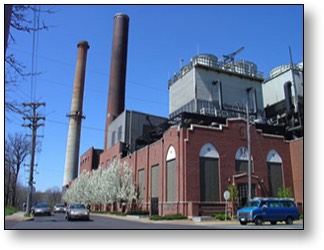
- Relax and have fun
- Keep the trains under 45 scale mph
- Anything odd or unclear, haul it back to Franklin Yard
- If you know a better way, let the layout owner know.
And during couple’s night…don’t forget couple’s night!
A Brief History of the MKT

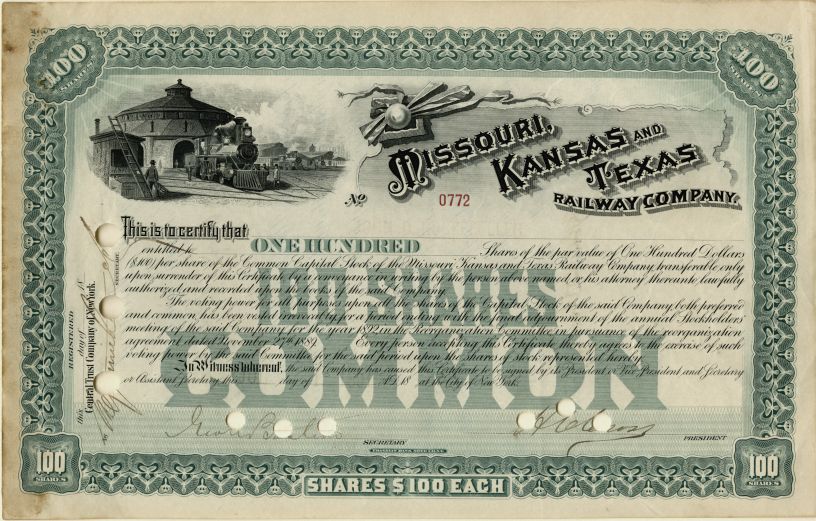
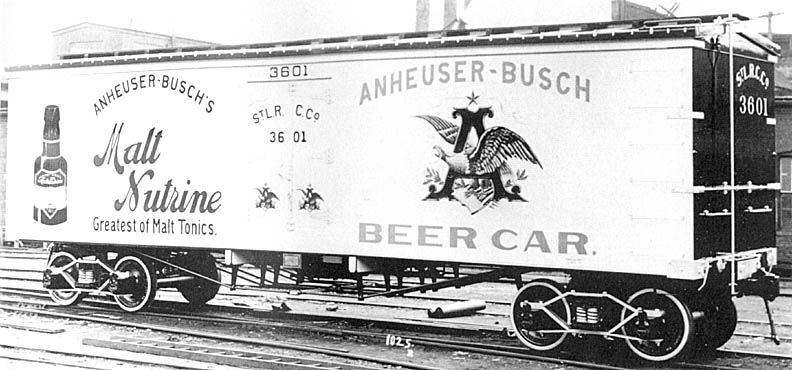
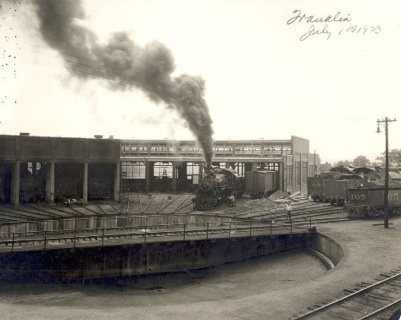
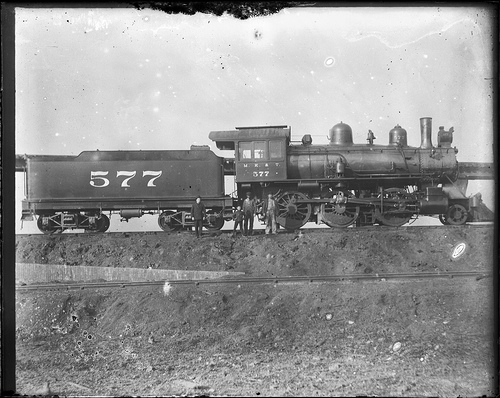
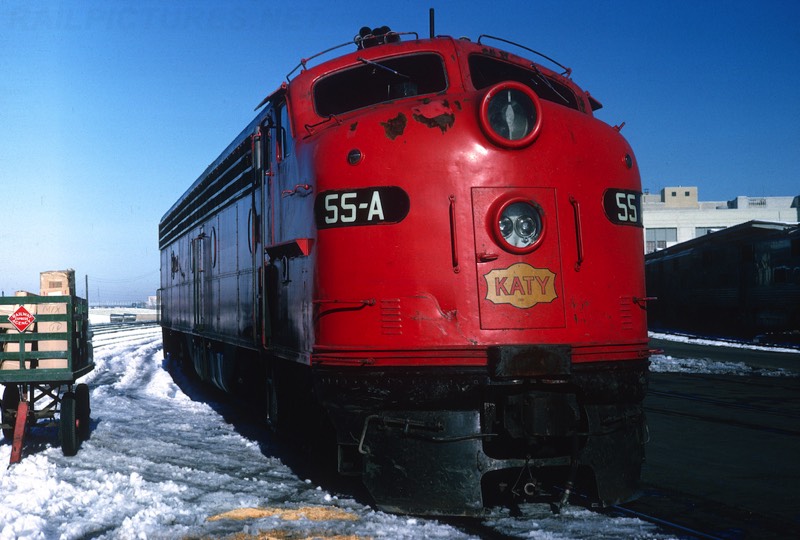
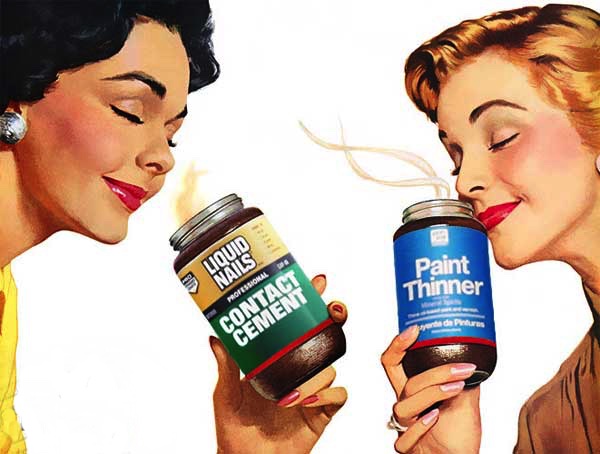

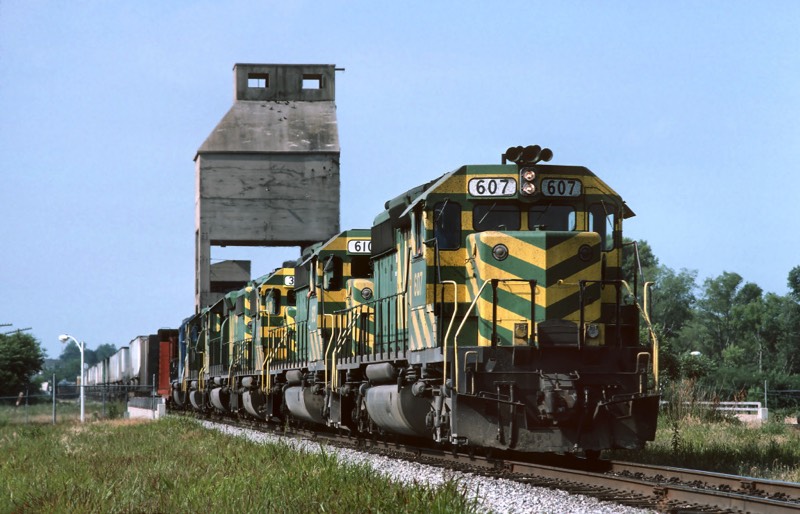
- Adapted from The Katy Flyer (Newsletter of the Katy Railroad Historical Society)
-

Empties along the Rochport Bluffs
-
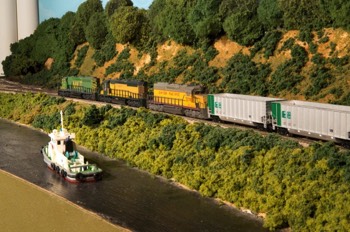
Empties along Missouri River near Rhineland
-
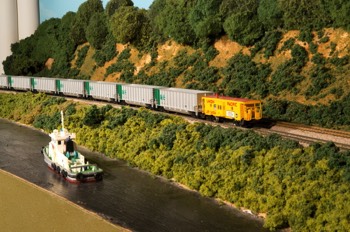
Empties along Missouri River near Rhineland
-
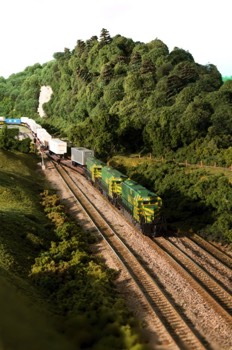
Pigs entering siding at West Mokane
-
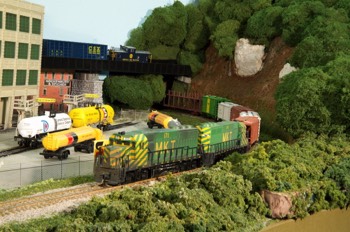
Freight passing Safety-Kleen at St. Charles
-
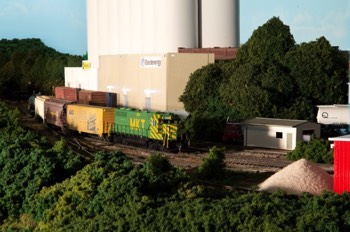
Local arriving Columbia
-
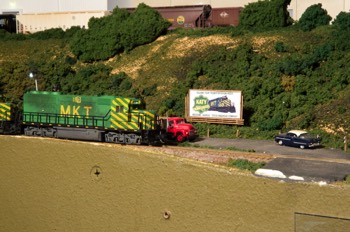
Loco at East Mokane
-
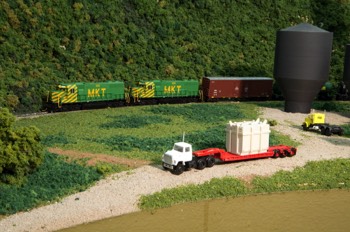
Locos Passing Westinghouse at North Jefferson
-

The farm at Rochport bluffs
-
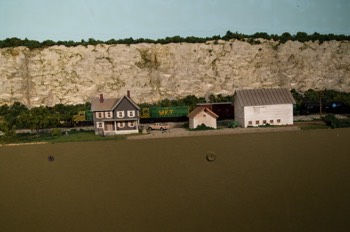
Locos passing the Rochport Bluffs
-
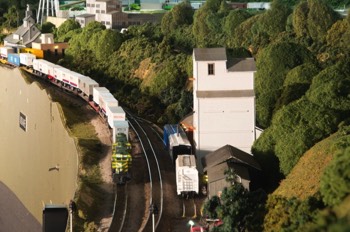
Pigs passing Mokane
-
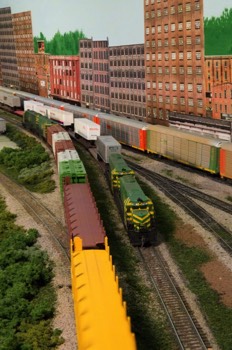
Action at St. Charles
-
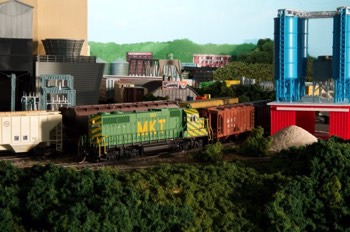
Working Johnson Cement at Columbia
-
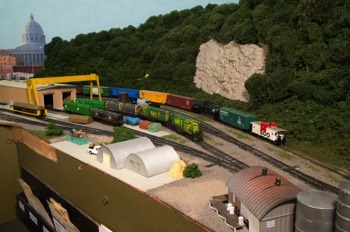
Work at Westinghouse in North Jefferson
-

Tavern Rock Sand and Gravel Company
-
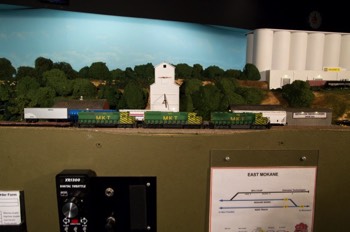
Locos at Mokane
-
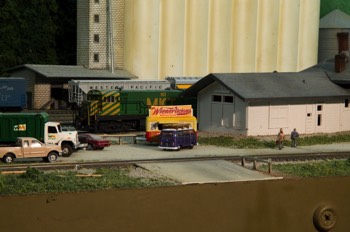
U-boat passing the Weiner Wagon at Boonville
-

The UP Columbia Local
-
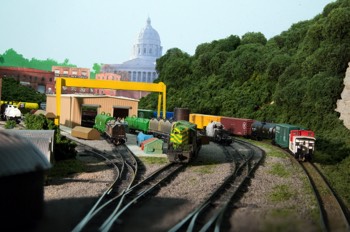
Working Westinghouse
-
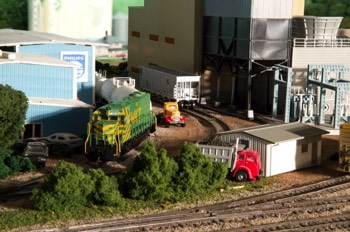
Working Philips Electronics at Columbia
-
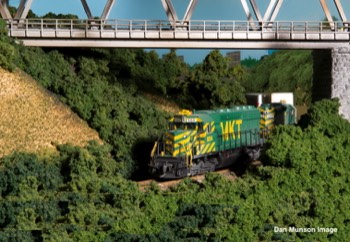
Pig train passing Riverside
-
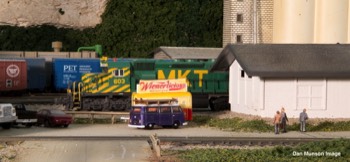
Passing Boonville
-
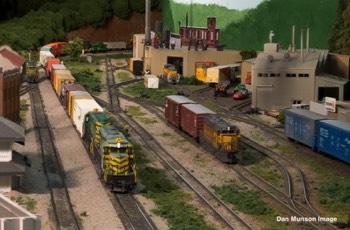
Freight passing Boonville as the local works the interchange track
-
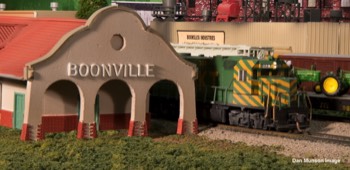
The old Boonville Depot
-
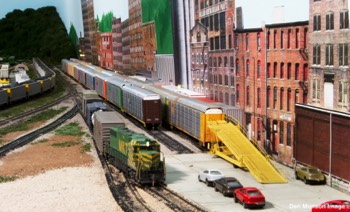
The autorack facility at St. Charles
-
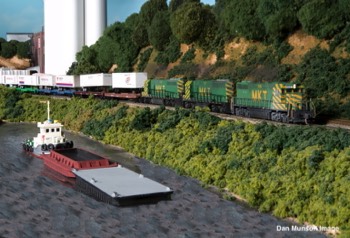
Pigs by the river
-
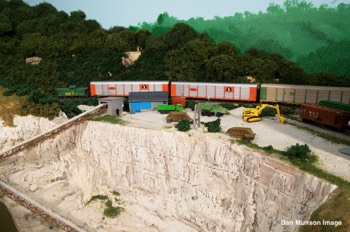
Racks running by Tavern Rock
-
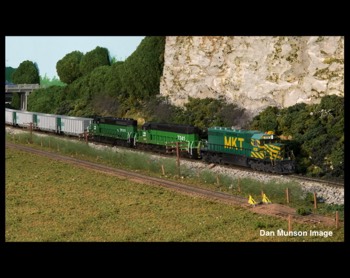
EB Coal drag at Rocheport
-
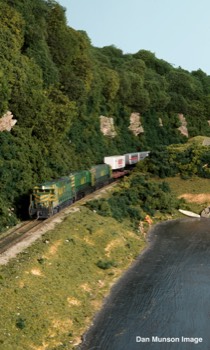
WB Pigs at Rocheport
-
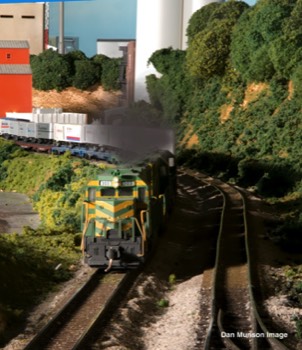
EB Pigs rounding the North Jefferson curve
The Mighty MKT, St. Louis Subdivision proudly serves:
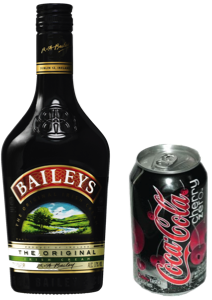
Baileys Irish Cream, the official adult beverage of the Mighty MKT, St. Louis Subdivision! Imbibed by elite operators and expert decoder installers everywhere.
Cherry Coke Zero, the official soft drink and mixer of the Mighty MKT! Sipped by discriminating yardmasters and proficient dispatchers everywhere.

